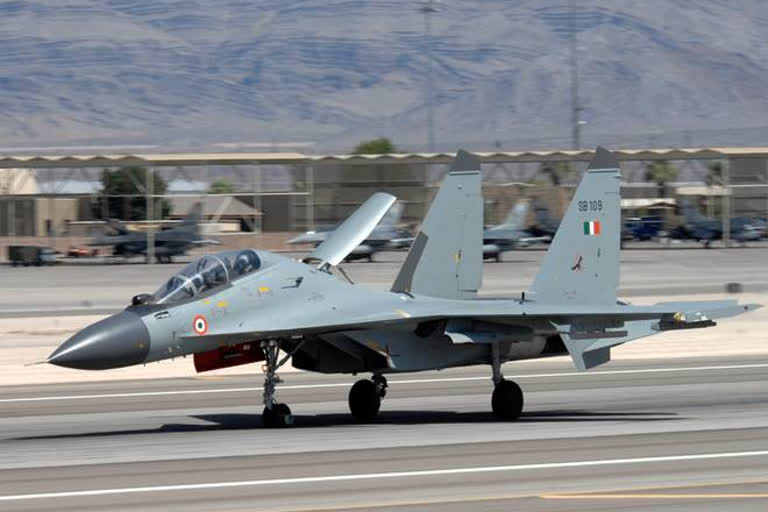New Delhi: Faced with a very belligerent China in the backdrop of a very tense face-off eastern Ladakh, an ever-hostile Pakistan, and a growing prospect of a two-front conflict scenario, the Indian government has approved the acquisition of 33 new aircraft—including the 21 MIG-29 and 12 Sukhoi 30 MKI—to make up for a worrisome gap in the country’s air force.
Interestingly, both are Russian origin aircraft although Sukhoi 30 MKI is license-manufactured at Hindustan Aeronautics Limited (HAL) in Bengaluru. The development is also significant as Russia is perceived to be close to both India and China and has sold the powerful S-400 air defence system to China while India is in the process of acquiring the anti-missile system.
The decision on the new procurement was taken in the Defence Acquisition Council (DAC) meeting on Thursday that was chaired by the Defence Minister Rajnath Singh. The DAC is the apex procurement body in the ministry.
The proposals will now be placed before the Cabinet Committee on Security (CCS) for the final approval.
The DAC also decided to upgrade 59 MIG-29s already with the Indian Air Force (IAF).
A government release said: “While the MIG-29 procurement and upgradation from Russia is estimated to cost Rs 7,418 crore, the Su-30 MKI will be procured from HAL at an estimated cost of Rs 10,730 crore.”
These new aircraft will be in addition to the 36 Rafale state-of-the-art jets with the first batch of six Rafales from France expected to land in India by the month-end. One Rafale squadron will be based in Ambala and the other in Hashimara in northern West Bengal.
In March, the DAC had also given the go-ahead to the buying of a fleet of 83 Mk1A version of the Tejas Light Combat Aircraft at about Rs 38,667 crore. An additional order of about 40 Tejas aircraft is understood to be in the pipeline.
At present, the IAF has about 33 fighter squadrons or about 600 aircraft which is much less than the desired strength of about 800 about fighter aircraft which is the number the air force needs in case of a two-front conflict with China and Pakistan.
With these new acquisitions, the IAF would add more than 190 fighters to its fleet according to back-of-the-envelope calculations—just about making up for the shortfall in numbers.
Although it is the world’s fourth-largest air force in terms of personnel and aircraft, the IAF has to operate in an air space spanning more than 40 million cubic km.
As of now, the mainstays of IAF’s fighter aircraft comprise Su-30s, MiG-29s and Mirage-2000s. Presently, more than half of IAF’s fighter strength is positioned across the three China-facing commands. In contrast, China has less than 200 fighter aircraft under its India-centric Western Theater Command although there is a formidable armoury of sophisticated drones.
In total, on Thursday, the DAC cleared various proposals of capital acquisitions of various military platforms and equipment to the tune of Rs 38,900 crore which includes Rs 31,130 crore worth of equipment that will focus on indigenous design and development.
“The Indigenous content in some of these projects is up to 80 per cent of the project cost. A large number of these projects have been made possible due to Transfer of Technology by DRDO to the Indigenous Industry,” the release said.
Some of these projects include Pinaka ammunition, BMP armament upgrades and Software Defined Radios (SDR) for the Army, Long Range Land Attack Cruise Missile Systems and Astra Missiles for Navy and Air Force. “The cost of these design and development proposals is in the range of Rs 20 400 crore.”
“The air-to-air Astra missile, Software Defined Radio, Pinaka ammunitions and land-attack cruise missiles are state-of-the-art systems developed by DRDO,” stated Dr G Satheesh Reddy, chairman, DRDO.
Induction of Astra Missiles having Beyond Visual Range (BVR) capability will serve as a force multiplier and immensely add to the strike capability of Navy and IAF.
The air variant of the all-weather, day-and-night capable Astra is designed to engage and destroy highly manoeuvring supersonic aircraft. The Astra Mk-I variant is being integrated with the SU-30 Mk-I aircraft and is being inducted into the IAF.
SDR is a secure indigenous system with legacy communication support and secure digital voice and data communication for naval applications in both ‘man-pack’ and ‘hand-held’ roles.
The Pinaka multi-barrel rocket launcher is an all-weather, indirect fire, free flight artillery rocket system. New ammunition for the Pinaka will enable the raising of additional regiments.
On the other hand, the long-range land-attack cruise missile systems (LRLACM) with a range of 1,000 km will bolster attack capabilities of the Navy and IAF.
“Presently, lead in projects have developed, demonstrated and matured critical cruise missile technologies such as aerodynamic configuration, vertical launch using solid booster, thrust vector control system, booster separation, in-flight wing deployment, in-flight engine start and long-range way-point navigation system,” the DRDO chairman said.
“Seeker development and testing by DRDO laboratories are demonstrated and is at a high level of readiness. Thus, it is important to take up the proposed development of fully indigenous long-range land-attack cruise missile that greatly enhances the operational capability of services,” Dr Reddy added.
ALSO READ: Chinese App Ban: 'Digital Strike' to protect data of countrymen, says Ravi Shankar Prasad



